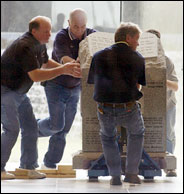

 |
| Associated Press |
| A crew moved the monument from the rotunda of the Alabama Judicial Building in Montgomery, Ala., on Wednesday morning. |
 |
| Associated Press |
| Crowds outside the judicial courthouse in Alabama protested after the Ten Commandments monument was moved. |
MONTGOMERY, Ala., Aug. 27 — After two years of controversy, a week of protests that resembled revivals and $1 million in lawyers' fees, the Ten Commandments standoff was resolved today in about an hour, by five men and a jack.
A moving crew, hired from out of state because no Alabama company would do it, lifted the 5,280-pound Ten Commandments monument installed by Chief Justice Roy Moore of Alabama, slid a wheeled jack underneath and rolled it away.
All the speculation about the slab of granite crashing through the floor of the Alabama Supreme Court or being too heavy to budge vanished as the moving crew pushed it past a set of pillars and out of public view, as federal courts have demanded.
Dozens of protesters watched, furious and helpless, from behind the locked glass doors of the courthouse.
Many have been camping on the courthouse steps, wearing their beliefs on their backs, with T-shirts reading "Jesus is the Standard" and "Satan is a Nerd."
As the workers readied the monument, a preacher belted out, "Pray the wheels crumble!"
After they did not, protesters started screaming: "Bring the monument back! Bring the monument back!"
Chief Justice Moore, who was suspended last week for defying a federal court order to remove the monument from the rotunda, was nowhere to be found.
He issued a statement saying, "It is a sad day in our country when the moral foundation of our law and the acknowledgment of God has to be hidden from public view to appease a federal judge."
A federal court in Montgomery ruled that the monument, known as Roy's Rock, violated the separation of church and state. Chief Justice Moore was given until midnight Aug. 20 to remove it. Some of his supporters had filed another federal lawsuit in in Mobile, Ala., challenging the decision by the judge in Montgomery. The judge in Mobile dismissed the suit today, saying he did not have authority in the case.
That leaves Chief Justice Moore, who once enjoyed the support of Alabama's power elite, with few options, because legal analysts say they believe the United States Supreme Court will not intervene. The court has already denied one of Chief Justice Moore's appeals.
"As far as we're concerned, this case is closed," said Morris Dees, chief trial counsel for the Southern Poverty Law Center, one of the civil liberties groups that sued to have the monument moved. Mr. Dees estimated that legal fees in the case were more than $1 million and that the state of Alabama would have to pay most of them.
For now, the monument is in a locked back room in the Alabama Supreme Court. Court officials have not indicated what they will ultimately do with it.
Protesters, though, continued to flock to Montgomery. All day they blew ram's horns, shook Bibles, passed out cans of Coke and knelt on the courthouse steps under a punishing sun.
"This is just the beginning," said the Rev. Patrick Mahoney, director of the Christian Defense Coalition. "We're going to call everybody we know and tell them to come to Montgomery to look inside that empty building and see what the future of America looks like."
Charles Tourney, whose family owns the Birmingham memorial company that built the monument, said that when he first got the order in 2001, "We assumed it was for a cemetery, a church, or maybe a park."
Mr. Tourney, along with several other Alabama monument companies, refused to move the stone. That left court officials searching this week for someone to lift the hunk of granite, which is heavier than a pick-up truck.
A company from Georgia was hired, Mr. Mahoney said, and around 8 a.m., the movers began levering up the monument, inch by inch. As one man leaned mightily on a 10-foot pole, his comrades slid pieces of plywood underneath.
By 9 a.m., to the dismay of protesters, there were a few inches of daylight between the bottom of the monument and the courthouse floor.
"Lord," one protester yelled, "it's never too late to repent."
A few minutes later, a wheeled jack used to move pallets was rolled underneath the monument. Four of the movers got behind the stone block and pushed, while one man pulled the handle of the jack. It looked about as difficult as pushing a car that has run out of gas.
Ken Barnett, a 58-year-old Alabama state employee, yelled: "Cowards! Open the door! Let me in there!"
Other demonstrators told him to calm down. As soon as the monument disappeared into the bowels of the courthouse, protest anger began to find a new place as well.
Protest organizers now say Attorney General Bill Pryor of Alabama is enemy No. 1. Mr. Pryor, who has been nominated by President Bush for an appellate judgeship, originally supported Chief Justice Moore but last week sided with the eight other justices when they voted to overrule Chief Justice Moore and move the monument.
"No man is above the law," Mr. Pryor said.
Mr. Pryor, 41, is now drawing heat from conservative groups who once supported him and liberal Democrats in the Senate who have held up his nomination.
"We feel betrayed," said Mr. Mahoney, who led a march to Mr. Pryor's office on Tuesday. "We worked for this guy, and he sold us out because he wants a new job."
Stephanie Cutter, a spokesman for Senator Edward M. Kennedy, Democrat of Massachusetts, said he remained opposed to Mr. Pryor's nomination. "What Bill Pryor was doing was simply enforcing a court order," Ms. Cutter said. "It's hard to give him credit for abiding by something that's not even a close constitutional question."
Mr. Pryor declined to discuss the matter. His office is prosecuting Chief Justice Moore for violating his oath by defying the federal court order. On Friday, Chief Justice Moore was suspended, with pay, pending a trial by the Alabama Court of the Judiciary.
It is not clear when that trial will start. The Court of the Judiciary has the power to remove Chief Justice Moore from the bench, though some political analysts say that will only add to his swelling popularity.